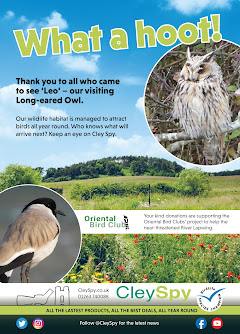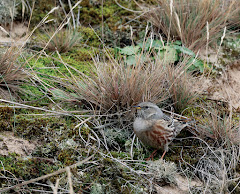Nature Notes
"One of the most extraordinary moths that I have ever been concerned with is the emperor moth, which flies in April and May.
It is generally distributed throughout the British Isles including Scottish islands. Its habitat preference is for heaths, moors, commons and waste ground. It is common locally, but like many wildlife creatures it is not so common as it once was.
Several decades ago a friend brought me a female emperor moth which he had foung on a common near King’s Lynn. The female of this species does not fly much at all as she is heavy with eggs. She must wait patiently until a male picks up the smell of her pheromones and pairs with her to fertilise her eggs. Within the hour, a male arrived and found my moth, although I had never seen this species in the area before...
From that moment in time I was able to rear for 13 years scores of caterpillars and moths which were released back in to the wild. The wing-span of the female is 70 millimetres, while the male only measures 60 millimetres. Both sexes are unmistakable with a round eye spot on each forewing and hindwing. The female is lethargic, but does fly at night, probably when she is egg laying. The male, however, flies rapidly in the sunshine, seeking out hidden females in hedgerows or bushes.
These moths ,which are members of the silk moth family, have no tongues so they are fairly easy to keep in captivity. Therefore they have a short life (probably no more than two weeks) but a merry one!
Their caterpillars, though, are voracious and will nibble through the leaves of bramble, sallow, sloe, heather, hawthorn and blackthorn. The adult caterpillar is well camouflaged, being bright green with black markings. A series of warts on its back sprout spiracles which are black, yellow or pinkish.
When fully fed the caterpillar then constructs a most wonderful haven in which to pass the ensuing months as a pupa. It is woven round a spray of twigs in the form of a bottle, wide at the base and narrow at the top. Silken threads are used which soon become very tough and impenetrable to predators. Their future exit hole for the moth to emerge is also cleverly constructed so that strong springy bristles all point towards the exit. Thus the adult moth is able to push itself outwards with the closed springs, whereas a predator would find it difficult to enter.
The old collectors well knew the habits of this and similar moths for they were able with a captive female to attract as many specimens as they needed to pin into their cabinets!
I note in the pages of the Lynn News that the unwelcome brown-tail moth is becoming increasingly common along the Norfolk coast.Entomologists have given this moth “pest status” because the caterpillar’s hairs can cause severe skin irritations.
When reaching large numbers their wind blown hairs can cause this problem and local pest control measures have been in existence for centuries. Their caterpillars construct and live in large webs usually on coastal scrub of bramble, hawthorn and willows. Their furry caterpillars are easily distinguished by two crimson spots at the end of the tail. I note that other trees have been defoliated, but this may be due to harmless micro moths whose caterpillars no doubt provide food for many birds. A few other moth species also construct webs in which their larva live but they present no problems. The yellow-tail is a separate species which does not make webs."








































No comments:
Post a Comment